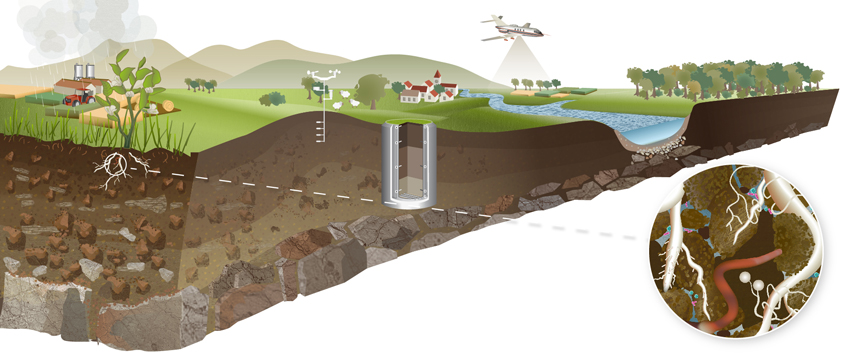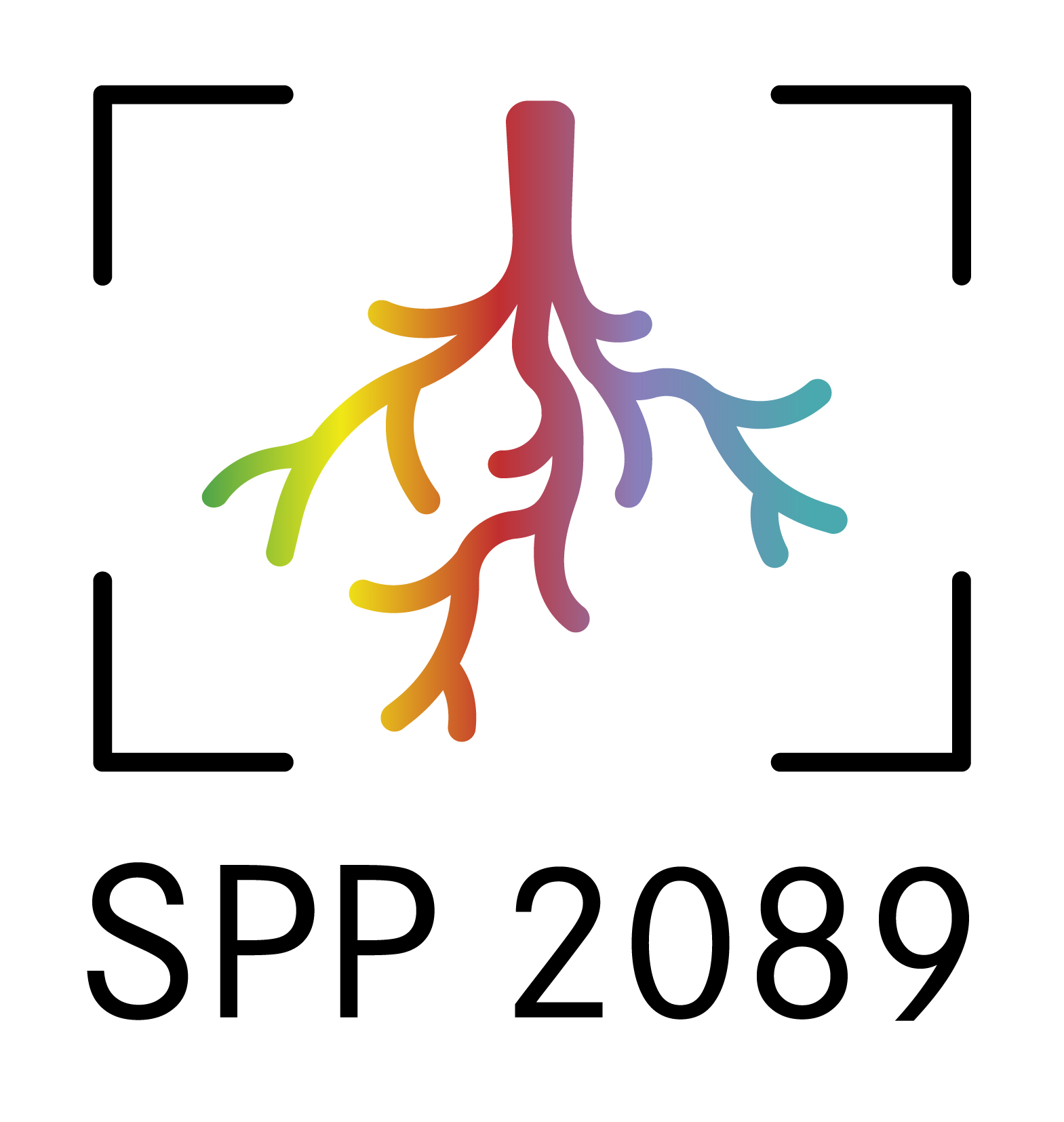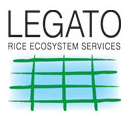
Abgeschlossene Forschungsprojekte
seit 2014
Messung und Modellierung von Bodenfunktionen
Funding: Deutsche Forschungsgemeinschaft - DFG
Project term: 2019 - 2023
Monitoring and modelling of non-equilibrium soil water dynamics and lateral subsurface flow in hillslope soils
In well-drained, unsaturated soils, water moves predominantly vertically. Lateral flow is initiated at locations where the soil approaches water saturation and capillary forces vanish. The onset of lateral flow along impeding soil horizon boundaries and other heterogeneities in hillslopes cannot be described realistically even with spatially-distributed 3D numerical models. A process-based model concept for transient lateral flow in the unsaturated zone of hillslope soils is still missing. One major difficulty to develop such a concept is that water dynamics in field soil exhibit non-equilibrium effects and hysteresis due to structural heterogeneities. Consequently, lateral flow is triggered already at local water potentials close to zero, i.e. far before complete water saturation occurs as is commonly assumed. Another difficulty is the need for a 2D or 3D representation of the hillslope and the corresponding high demand of both data and computing power.In this project, we develop a conceptual framework to described non-equilibrium dynamics and hysteresis for 1D vertical flow in a physically consistent way. The analysis will be based on unique data sets provided by the VAMOS lysimeter system and the TERENO-SoilCan lysimeter network, which monitor water contents and matric potentials in different field soils (3D) and lysimeters (1D) since 2013.
Contact:
Prof. Dr. Hans-Jörg Vogel
, Dr. Horst Herbert Gerke, Dr. Thomas Wöhling
Partner:
Leibniz-Zentrum für Agrarlandschaftsforschung (ZALF) e.V., Dresden University of Technology - TU Dresden
 Funding: Bundesministerium für Bildung und Forschung - BMBF
Funding: Bundesministerium für Bildung und Forschung - BMBF
Project term: since 2018
Innovative solutions for a sustainable agricultural land use in the dry steppes of Kazakhstan and southwestern Siberia
In the arid steppe regions of Kazakhstan and southwestern Siberia, the problems of soil degradation, climate change, and change of land use necessitates innovations for a sustainable use of agricultural resources. By a distinguished combination of research, development, and implementation, the project aims at developing innovative, sustainable, and climate-adapted agricultural concepts and to support infrastructure for an information and advisory system, based on an already perfectly established cooperation between scientists, German companies as well as local land users and other interest representatives.
SP 2 - Optimization of water supply by innovative soil management
Plant-accessible water is the limiting factor for agricultural yields in the steppe zone of Kazakhstan, especially in the light of the ongoing climate change with an increase in the mean annual temperatures along with more infrequent precipitation events in the study area. SP 2 aims at improving soil water supply to plants, e.g. by optimization of snow retention or by reducing unproductive evaporative water losses by ultra-shallow soil tillage practices. For that a novel weighable lysimeter station consisting of two gravitation lysimeters and allowing long-term online operation will be developed and implemented, and quantitative and qualitative parameters of the soil water budget will be recorded for different soil management systems. High-resolution measurements concern for example the determination of the actual evaporation. Being equipped with a multitude of atmosphere and soil, the lysimeter station of SP 2 will also serve as a basis for the recording climate change effects in the region of the Kazakh dry steppes and compared with the development in the Kulunda steppe in southwest Siberia, where another lysimeter station is running. With additional information from the analysis of plant water and nutrients uptake, efficient water management approaches for sustainable and resource saving agriculture will be developed.
Contact:
Partner: UGT
Web: http://rekks.eu/en
 Funding: Deutsche Forschungsgemeinschaft - DFG
Funding: Deutsche Forschungsgemeinschaft - DFG
Project term: 2016 - 2023
Denitrification in Agricultural Soils: Integrated control and Modelling at various scales
Denitrification, the process of nitrate reduction allowing microbes to
sustain respiration under anaerobic conditions, is the key process
returning reactive nitrogen as N2 to the atmosphere. The different
reaction steps (NO3- -> NO2- -> NO -> N2O -> N2) are enzymatically
mediated by a broad range of prokaryotes and some eukaryotes. Actively
denitrifying communities in soil show distinct regulatory phenotypes
(DRP) with characteristic controls on the single reaction steps and
end-products. It is unresolved whether DRPs are anchored in the
taxonomic composition of denitrifier communities and how environmental
conditions shape them. Despite being intensively studied for more than
100 years, denitrification rates and emissions of its gaseous products
can still not be satisfactorily predicted. While the impact of single
environmental parameters is well understood, the complexity of the
process itself with its intricate cellular regulation in response to
highly variable factors in the soil matrix prevents robust prediction
of gaseous emissions. Key parameters in soil are pO2, organic matter
content and quality, pH and the microbial community structure, which in
turn are affected by the soil structure, chemistry and soil-plant
interactions. Here, we aim at the quantitative prediction of
denitrification rates as a function of microscale soil structure,
organic matter quality, DRPs and atmospheric boundary conditions.
Combining state-of-the-art experimental and analytical tools (X-ray
µCT, 15N tracing, NanoSIMS, micro-sensors, advanced flux detection, NMR
spectroscopy, and molecular methods including next generation
sequencing of functional gene transcripts), we will study
denitrification processes at unprecedented spatial and temporal
resolution. Improved numerical methods and computational power will
allow to integrate results from the different groups and to develop
denitrification models ranging from the microscale (phase 1) to the
field/plot scale (phase 2).
Contact:
Dr. Steffen Schlüter , Prof. Dr. Hans-Jörg Vogel
Web: DASIM
 Funding: Deutsche Forschungsgemeinschaft - DFG
Funding: Deutsche Forschungsgemeinschaft - DFG
Project term: 2018 - 2024
Spatial organization of the liquid phase in the rhizosphere
The rhizosphere is crossed by a vast water flux and hosts a tremendous number of microorganisms, which together with the roots engineer the soil physical properties. Prominent among such engineering activity is the secretion of mucilage from the root tips, which changes key physical properties of the soil solution: it adsorbs water, it increases its viscosity and decreases its surface tension, affecting also the contact angle. By changing these properties, mucilage alters the soil hydraulic properties (the water retention curve and unsaturated hydraulic conductivity) and the soil moisture dynamics during drying/wetting cycles. Furthermore, mucilage brings into question well accepted paradigms, such as the fact that the soil water content should decrease towards the root surface (but it does not!) and the concept that capillary forces together with the adsorption of water films on the soil particle surface determine the spatial configuration of the gas–liquid interface. Indeed, the high elongational viscosity of mucilage is responsible for the formation of stable filaments and 2D structures such as hollow cylinders, which are not predicted by existing concepts in soil physics, and that contribute to maintain the root surface physically connected to drying soils.
In this project we aim to understand the fundamental physics of the interactions between mucilage and the soil matrix, their implications for rhizosphere processes (particularly related to water retention and flow) and plant growth. To achieve this goal, high resolution X-ray CT imaging of mucilage distribution in the rhizosphere will be combined with measurements of mucilage water-related properties, such as viscosity, surface tension and water potential. The expected outcome of this project is the understanding of the role mucilage in engineering the rhizosphere hydraulic properties.
Contact:
Dr. Steffen Schlüter
, Prof. Dr. Andrea Carminati
Web: SPP 2089 - P4
 Funding: Bundesministerium für Bildung und Forschung - BMBF
Funding: Bundesministerium für Bildung und Forschung - BMBF
Project term: 2015 -2020
Land-use intensity and Ecological Engineering – Assessment Tools for risks and Opportunities in irrigated rice based production systems
LEGATO aims to advance long-term sustainable development of irrigated rice fields, against risks arising from multiple aspects of global change. The overall objective is the elaboration and testing of generally applicable principles within the frame of ecological engineering – an emerging discipline, concerned with design, monitoring and construction of ecosystems.
The project plans to quantify the dependence of ecosystem functions and the services they generate in agricultural systems in three areas in Southeast Asia: Malaysia (Muda Irrigation Scheme), Vietnam (Tien Giang province in Mekong Delta and the Red River Valley from the Northwest mountain region to the delta) and The Philippines (Central Luzon from Banaue to Cabanatuan).
As core output, LEGATO will develop guidelines for optimising ecosystem functions and services given the local socio-cultural conditions and their stabilisation under future climate and land use change, which will particularly affect South and Southeast Asia. There is a clear need for crop productivity increases and diversification. LEGATO will analyse the potential of ecological engineering to achieve this, and test its implementation and transferability across regions. The latter is to be achieved through inclusion of local agricultural agencies and extension services as partners. Implementation will include assessments of ecosystem services risks and opportunities in the light of changes in land use intensity, biodiversity and climate.
Contact:
Prof. Dr. Doris Vetterlein
Web:
LEGATO
Funding: Deutsche Forschungsgemeinschaft (DFG) - Project number 252464214
Project term: 2014 to 2019
MUCILAGE: the hydraulic bridge between roots and soil
Water is the source for plant growth. In times of climate change, water scarcity will endanger food production worldwide. One mitigation strategy for sustaining food production is to improve the capability of crops to capture water from soils. The central hypothesis of our project is that mucilage exuded by roots favors the water flow into roots and it increases plant drought tolerance. We hypothesize that mucilage alters the physicochemical properties of the rhizosphere, in particular its water holding capacity and hydraulic conductivity, and that these alterations affect the water flow across the rhizosphere. Thanks to its high water holding capacity, mucilage maintains the rhizosphere wet and helps roots to stay in hydraulic contact with soil during drought, improving the hydraulic conductivity of the root-soil interface. However, as mucilage dries, it becomes hydrophobic and it may reduce the local root uptake. It is not clear whether such temporary hydrophobicity is a problem for the acquisition of water or, on the contrary, it is a strategy of plants to not lose water when the soil becomes too dry. Furthermore, it is not known how such characteristics depend on plant species and soil types. Objective of our project is to understand the mechanistic role of mucilage for the regulation of water supply to plants. We structured the project in three sub-projects with the following tasks: 1) to measure the physiochemical properties of mucilage, and in particular the binding characteristics and mobility of water in mucilage; to this end we will employ1H-NMR-relaxometry, diffusometry and differential scanning calorimetry. 2) To measure the water retention curve and the hydraulic conductivity of soil-gel mixtures; to this end we will mix PGA-Ca (model for mucilage) and real mucilage (collected from different Fabaceae and Poaceae) with soils of different particle size distribution. In a first step, the gel will be homogeneously mixed with sand; then it will be added around artificial roots (suction cups) to mimic mucilage distribution in the rhizosphere. 3) To measure the effects of mucilage and rhizosphere on root water uptake. To this end a root pressure probe will be applied to single roots grown in soils. The measurements will be coupled with neutron radiography of water distribution in the rhizosphere. The experiments will be simulated with a numerical model of water flow into a single root including mucilage-rhizosphere dynamics. The three sub-projects are planned to stepwise link the processes at the supramolecular scale with the macroscopic soil hydraulic properties and root water uptake. The expected outcome of the project is the understanding of the role of mucilage on soil-plant water relations and its importance for improving plant drought tolerance.
Contact: Prof. Dr. Doris Vetterlein , Prof. Dr. Andrea Carminati; Prof. Dr. Gabriele Schauman
Web: MUCILAGE
Finanzierung durch: DFG
Projektlaufzeit: 2010 - 2015
Pflanzeninduzierte Verwitterung von Mineralen im Unterboden Freisetzung von nicht austauschbarem Kalium aus 2:1 Schichtsilikaten (TransMinK)
Ziel des Antrages ist es, das Potential des Unterbodens zur K Versorgung von Kulturen beizutragen, zu erfassen. Spezifisch werden die Prozesse untersucht, welche die Freisetzung von K aus den Zwischenschichten von 2:1 Tonmineralen kontrollieren, da erwartet wird, dass dies die dominante Bindungsform von K im Unterboden ist. Es ist gut dokumentiert, dass Wurzelaktivität zur Freisetzung des sogenannten ‘nicht-austauschbaren’ Kaliums führen kann. Kontrovers diskutiert wird, welche K Konzentration in der Rhizosphäre vorliegen muss um die Freisetzung zu ermöglichen. Darüber hinaus fehlen Informationen zur Dynamik von weiteren Kationen (Ca, NH4) in der Rhizosphäre und deren Einfluss auf die K Freisetzung und den Prozess der Vermiculitisierung, der damit in Verbindung steht. In Kompartimentsystemen, ausgestattet mit Mikrosaugkerzen, werden Modelluntersuchungen mit Substrat vom zentralen Feldexperiment durchgeführt. Die Dynamik der Bodenlösungszusammensetzung mit zunehmendem Abstand von der Wurzeloberfläche wird erfasst und mit mineralogischen Untersuchungen mittels Röntgenbeugung, und Elektronenmikroskopie kombiniert. Veränderungen in der Tonmineralogie als Folge der Kaliumaufnahme der Pflanzen werden auch an wurzelnahen und wurzelfernen Bodenproben im Feld und im zentralen Mikrokosmenversuch, sowie an im Feld während einer Wachstumsperiode exponierten Testmineralen untersucht. Schließlich ergänzen röntgencomputertomographische Untersuchungen zur Veränderung der Bodentextur in Wurzelnähe und zur Erschließung von Bioporen durch die Wurzeln das Untersuchungsprogramm.
Ausführende Einrichtung:
- Martin-Luther-Universität Halle-Wittenberg (MLU)
Mitwirkende Einrichtungen
- Helmholtz Zentrum für Umweltforschung GmbH (UFZ)
- Institut für Agrar- und Ernährungswissenschaften (IAEW)
- Lehrstuhl für Agrarökologie und Organischer Landbau (AOL)
Kontakt: Prof. Dr. Doris Vetterlein
Weitere abgeschlossene Projekte der Arbeitsgruppe:
- Structure - Ausbildung der Bodenstruktur durch Mikroorganismen und Pflanzen (Projektlaufzeit 2016 - 2021) (Finanzierung: DFG)
- BASS - Helmholtz-Hochschul Young Investigators Group (Projektlaufzeit 2004 - 2009) (Finanzierung: Helmholtz Socienty)
- HEOP - Durch Pflanzen induzierte Heterogenität des osmotischen Potentials in Böden. Bedeutung für Wasseraufnahme und Wachstum der Pflanzen (Projektlaufzeit 2000 - 2004) (Finanzierung: DFG)
 Project term: 2019 - 2021
Project term: 2019 - 2021
Project: Agricultural and aquatic systems
The aim of the “Agricultural and aquatic systems” project is to record the development of these sensitive and complex systems with regard to climatic extremes in Germany. We want to predict as closely as possible the development of soil functions, agricultural productivity, as well as the water quality of river ecosystems for different climate scenarios.
Contact: Prof. Dr. Mareike Ließ,
Prof. Dr. Hans-Jörg Vogel
,
Prof. Dr. Markus Weitere
, Prof. Dr. Claudia Künzer
Partner: DLR
Web: Hi-Cam
